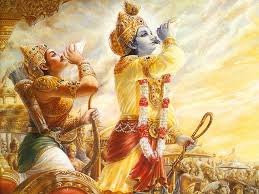
The era goes back to thousands of years. Lord Krishna, amidst the epic battle of Kurukshetra spoke sagely the divine words of wisdom- the Bhagvad Gita – to his devotee Prince Arjuna – “The soul is unborn and eternal. The soul is not destroyed when the body is destroyed.”
You may indeed be perplexed and would even protest – The article was supposed to be scholastic and not spiritual! Bhagvad Gita? GST? What an implausible connection as impossible as it sounds!
Well, calm down. Because, delving down on a deeper level, the above adage from Holy Gita connects quite aptly and righty with the coming era of GST.
Allow me to elaborate this enlightening connection –
We all know that seventeen taxes – Service tax, Sale Tax, Excise, Entry Tax, etc, – under Indirect Taxation will be replaced by a uniform levy called Goods and Service Tax. From Gita’s perspective, it wouldn’t be wrong to say: The Old Body of seventeen taxes under Indirect Taxation will die away, but the Soul of Indirect Taxation will prevail to take birth in a New Body called as Goods and Service Tax.
Elaborating further, the Soul, the very essence of Indirect Taxation will carry on; the Body, however, will be a new cocoon of altered rules, fresh regulations, streamlined methods and simplified processes. Speaking metaphorically, a soul evolves as the body evades, a soul progresses as the body perishes, and thus, the Soul of Indirect Taxation will flourish as the old Body vanishes!
Zeroing in on another verse from Bhagvad Gita, Lord Krishna rightly proclaims: “Dharma will conquer Adharma, truth will prevail over falsehood. The power behind death, disease and sin will be overcome by the reality which is Being, Intelligence and Bliss”
The upcoming age of GST epitomises the above adage. Think meticulously – under the current Indirect Tax regime, despite the advent of online system, the manual procedures and paper-works for registrations, forms, refunds, etc, are still at large giving way to inequalities, beleaguered bureaucratic procedures and corruption – the insidious ingredients of “Adharma”. And GST, symbolising the “Dharma”, is expected to prevail over the fallacies and faults of the system and clean the corrosion of corruption. GST, expectantly, will usher in an era of integrated systems, transparent online mechanism, uniform procedures, financial discipline and economic balance across the length and breadth of the country.
Nevertheless, it may be pertinent to say that the sway of “Adhrama” – the corruption – cannot be wiped off altogether but, yes, it can certainly and continually be fought to keep the evils at bay.
As a conclusion, like the sacred scripture of “Bhagvad Gita” sprinkles divine words of wisdom on humanity, the emerging era of ‘Goods and Service Tax’ will, hopefully, take a leaf out of the “Gita” and guide the Indian Economy conscientiously and sprinkle Truth, Justice and Equality.
__________________________________________________________________
Note: The article is originally written by Saurav Somani and has the copyright on the same. According to the Copyright laws if the article is copied by anyone and posted in any forum, manually or electronically, due mention or reference shall be given to the original artist or author.

Interesting ! I came across your blog as I was searching for some good articles on my home City, Kurukshetra -the Land of Mahabharata as I too recently wrote a blog on this the mythological city & wanted to know what all a visitor’s eye might have captured that I could not…but then your write up came up and I must tell you that it is no less engaging .
LikeLike
Thanks a lot, buddy!
LikeLiked by 1 person